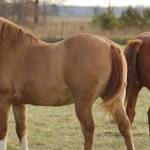Using Weight Tapes on Horses

The concept is simple. Just wrap the weight tape around the horse, read off the figures where the end of the tape overlaps the numbered section, and you know how much your horse weighs! Easy and fail-safe, right?
To get the best results in the use of a weight tape, it’s important to be consistent. Equine nutritionist Kathleen Crandell, Ph.D., explains that the weight tape is a wonderful tool, but it probably won’t yield a dead-on accurate weight for your horse for several reasons.
“First, there is no standard for these tapes, so the weight estimate can change for a particular horse depending on which tape is used. You’ll get a weight that is within a few hundred pounds of your horse’s actual weight with any tape, and probably a closer answer with some tapes than with others,” Crandell said. “However, you won’t know which is the most nearly correct or whether the figures are above or below your horse’s real weight.”
Second, a particular type of tape will be more accurate on some horses than on others, depending mostly on breed. Because of differences in conformation and body proportions, tapes tend to weigh Thoroughbreds about 50 to 100 pounds light, and may underestimate the weight of a Warmblood by as much as 200 pounds, explained Crandell. “The same tape will probably be fairly accurate on a Quarter Horse as well as other equines that are somewhat heavier-bodied and shorter-legged compared to Thoroughbreds.”
Crandell emphasized that despite their shortcomings, weight tapes can be very useful in determining trends in a horse’s weight. If you change the horse’s feed management—for example, putting him in a drylot or using a grazing muzzle to limit intake of pasture forage—and want to see if he is losing weight from month to month, a weight tape can indicate whether this change is taking place.
To get the best results in the use of a weight tape, it’s important to be consistent. “Use the same tape each time, and read the directions on the tape to see where it is to be placed. Some tapes are supposed to be run over the highest point of the horse’s withers, while others are designed to lie slightly to the rear of this spot,” she said. “Likewise, some are to be placed right behind the elbow but a few should be a hand’s breadth further back on the belly. However the tape is placed, it should be used in the same position every time the horse is measured. If possible, have the same person place and read the tape, pulling it snug but not tight around the horse’s body.”
If you have a chance to get a true body weight by putting the horse on an equine scale, use the weight tape soon afterward and record the difference between the two numbers. This will allow you to convert the numbers from the tape to the horse’s actual weight in the future.








